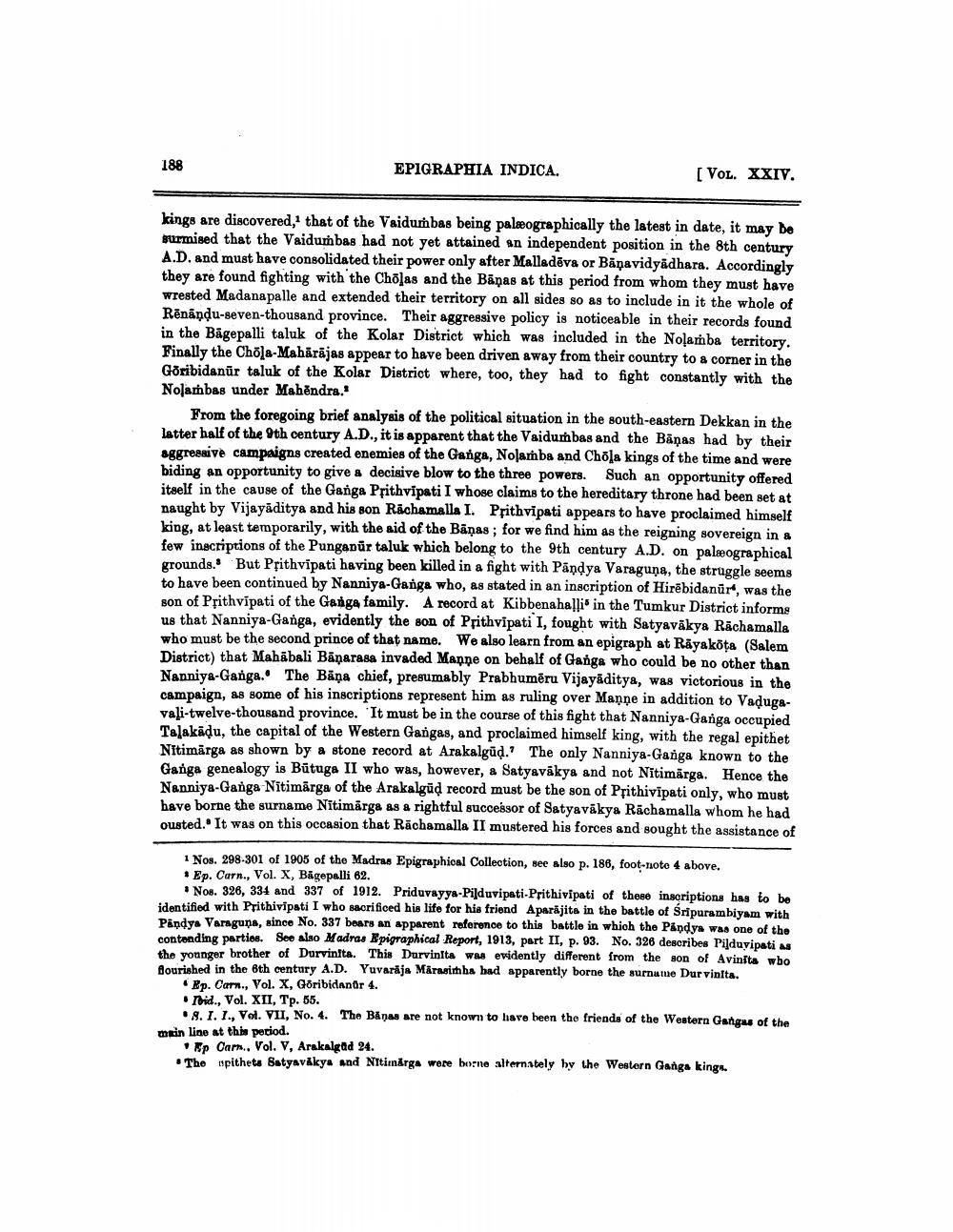________________
188
EPIGRAPHIA INDICA.
[VOL. XXIV.
kings are discovered,1 that of the Vaidumbas being paleographically the latest in date, it may be surmised that the Vaidumbas had not yet attained an independent position in the 8th century A.D. and must have consolidated their power only after Malladeva or Banavidyadhara. Accordingly they are found fighting with the Chōlas and the Bāņas at this period from whom they must have wrested Madanapalle and extended their territory on all sides so as to include in it the whole of Rēnandu-seven-thousand province. Their aggressive policy is noticeable in their records found in the Bagepalli taluk of the Kolar District which was included in the Nolamba territory. Finally the Chōla-Mahārājas appear to have been driven away from their country to a corner in the Göribidanur taluk of the Kolar District where, too, they had to fight constantly with the Nolambas under Mahendra."
From the foregoing brief analysis of the political situation in the south-eastern Dekkan in the latter half of the 9th century A.D., it is apparent that the Vaidumbas and the Banas had by their aggressive campaigns created enemies of the Ganga, Nolamba and Chōla kings of the time and were biding an opportunity to give a decisive blow to the three powers. Such an opportunity offered itself in the cause of the Ganga Prithvipati I whose claims to the hereditary throne had been set at naught by Vijayaditya and his son Rachamalla I. Prithvipati appears to have proclaimed himself king, at least temporarily, with the aid of the Banas; for we find him as the reigning sovereign in a few inscriptions of the Punganur taluk which belong to the 9th century A.D. on palæographical grounds. But Prithvipati having been killed in a fight with Pandya Varaguna, the struggle seems to have been continued by Nanniya-Ganga who, as stated in an inscription of Hirebidanur, was the son of Prithvipati of the Ganga family. A record at Kibbenahalli in the Tumkur District informs us that Nanniya-Ganga, evidently the son of Prithvipati I, fought with Satyavakya Rachamalla who must be the second prince of that name. We also learn from an epigraph at Rayakōta (Salem District) that Mahabali Banarasa invaded Manne on behalf of Ganga who could be no other than Nanniya-Ganga. The Bana chief, presumably Prabhumēru Vijayaditya, was victorious in the campaign, as some of his inscriptions represent him as ruling over Manne in addition to Vadugavali-twelve-thousand province. It must be in the course of this fight that Nanniya-Ganga occupied Talakādu, the capital of the Western Gangas, and proclaimed himself king, with the regal epithet Nitimärga as shown by a stone record at Arakalgud." The only Nanniya-Ganga known to the Ganga genealogy is Būtuga II who was, however, a Satyavakya and not Nitimärga. Hence the Nanniya-Ganga Nitimarga of the Arakalgud record must be the son of Prithivipati only, who must have borne the surname Nitimärga as a rightful successor of Satyavakya Rachamalla whom he had ousted. It was on this occasion that Rachamalla II mustered his forces and sought the assistance of
1 Nos. 298-301 of 1905 of the Madras Epigraphical Collection, see also p. 186, foot-note 4 above. * Ep. Carn., Vol. X, Bagepalli 62.
Nos. 326, 334 and 337 of 1912. Priduvayya-Pilduvipati-Prithivipati of these inscriptions has to be identified with Prithivipati I who sacrificed his life for his friend Aparajita in the battle of Śripurambiyam with Pandya Varaguna, since No. 337 bears an apparent reference to this battle in which the Pandya was one of the contending parties. See also Madras Epigraphical Report, 1913, part II, p. 93. No. 326 describes Pilduvipati as the younger brother of Durvinita. This Durvinita was evidently different from the son of Avinita who flourished in the 6th century A.D. Yuvaraja Marasimhha had apparently borne the surname Durvinita.
Ep. Carn., Vol. X, Gōribidanur 4.
Ibid., Vol. XII, Tp. 55.
8. I. I., Vol. VII, No. 4. The Banas are not known to have been the friends of the Western Gangas of the main line at this period.
Ep Carn., Vol. V, Arakalgud 24.
The pithets Satyavakya and Nitimärga were borne alternately by the Western Ganga kings.




